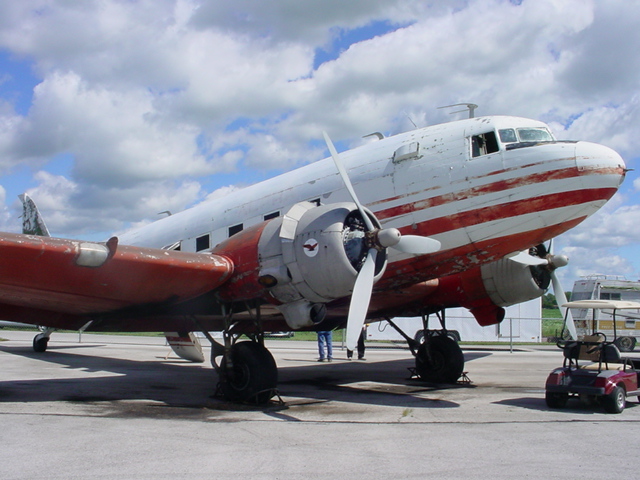A weathered DC-3 airplane with a colorful history sits in a hangar at the Fremont Airport. Built in 1943, the plane was part of the D-Day invasion, shuttling paratroopers to Normandy in northern France.
Rex Damschroder, the operator of the airport, hopes to restore the plane in time to fly it to France for the 75th anniversary of the invasion in 2019. To do so, he will need to raise $250,000 for the restoration and the flight.
“You change the engines and paint it up, and it’s a feasible airplane,” he said.
The plane has been at the Fremont Airport since 1988. In the intervening years between Normandy and Fremont, it has been used as a plane for parachutists and as a show plane in the Kings Island amusement park. There are even rumors that it had been used for drug smuggling at one point.
As originally built, the plane was a C-53D. It was converted to a DC-3 after the war. After the conversion, it was used by the 8th Air Force to carry paratroopers and to tow gliders. It can hold approximately 30 paratroopers per trip. “It wasn’t built for cargo. It was just for paratroopers,” according to Damschroder.
Rex’s father, Gene Damschroder, bought the plane in 1988 and flew it to the airport where it has remained. Damschroder has started restoring the plane by stripping the paint. He intends to repaint it in the original Army green D-Day color. The interior will need some work, including the cockpit.
If you want to make a donation to save this warbird, click here!
He has tested the airplane every year that it has been at the airport. The engines are in working order. It’s hard, though, to find replacement parts for a World War II-era aircraft. For example, to replace a rusted rudder that fell off the plane, Damschroder had to drive to Topeka, Kansas.
Damschroder is a former state legislator and a longtime local politician. He’s been flying for 50 years. He says that there are three major challenges – get the plane looking right, get it flying, and get the money needed to complete the restoration and fly it to and from France.
Organizers want 25 DC-3s to make the trip to Normandy. The 75th anniversary may be the last time a living crew member from a DC-3 would be able to participate in a D-Day commemoration.
Damschroder says that the plane can continue to be flown indefinitely as long as it is maintained.
“It can go on for eternity if you take care of it,” he said.
When Damschroder was younger, he worked as a ferry pilot and made 23 Atlantic crossings. He intends to be the pilot when the plane is flown to France. After the D-Day event, he would like to turn the plane into a flying classroom, where students can learn about D-Day and World War II.
His father was a Navy pilot. Damschroder sees the trip to France as both an adventure and a salute to World War II and its effect on the U.S.
“I think it was one of the largest, greatest wars of all time,” he said.
 Saving DC-3 Lulu Belle"
title="Image Source:
Saving DC-3 Lulu Belle"
title="Image Source: